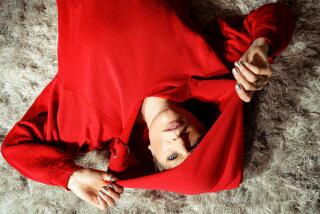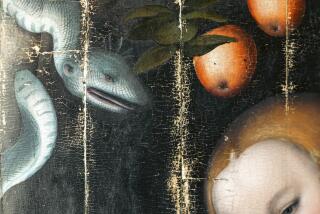Krasner’s True Legacy
Lee Krasner (1908-1984) was nearly 40 when she painted her first mature work as an artist. She had been painting since she was 18--first as a student, then on her own and eventually with the influential German emigre artist and teacher Hans Hofmann. Her progress was slow but steady.
In the concise and informative retrospective exhibition of her work that opened Sunday at the Los Angeles County Museum of Art, those first two decades are dispensed with quickly, in fewer than a dozen paintings and drawings: a Realist self-portrait, a Surrealist landscape, some Hofmann-esque abstracted still lifes in high-contrast color edged in black, several archaic pictographs. The show’s first room plus half of the second are like a concentrated tour of the artistic interests of American artists from the Depression years to the end of World War II.
Today, when art students just coming out of graduate school seem anxious for immediate large-scale exposure, it’s instructive to see just how long Krasner worked before her art began to take provocative form.
It’s also instructive in terms of understanding the dogged conviction Krasner had in her abilities as a painter. Artistically she was not the equal of the finest of her colleagues in the first generation of New York Abstract Expressionists--the likes of Willem de Kooning, Mark Rothko, Jackson Pollock (whom she married in 1945). But when her own work came together around 1947 or 1948, she was ready. For the rest of her life she grappled with a complex set of interests (often literary) and produced a number of lively and compelling works.
Krasner’s breakthrough came in a group of paintings (she often worked in loosely connected series) informally called the “Little Images” (1947-1950). The canvas, usually small, is approached as a kind of writing surface. The marks of the brush are not to be read as direct correspondences with written language, though, but as an almost mystical avenue in the search for meaning.
In paintings like the lovely “The Mouse Trap,” a densely packed tangle of cuneiform marks in red, yellow, violet, green, ochre, black and white creates an even web of mottled color from edge to edge of the small canvas (it’s just 30 inches high and 25 inches wide). The web establishes a taut, airy, light-filled visual scrim, evenly distributed across the surface. Your eye seems to look through this painted surface, catching disordered glimpses of something indistinct beyond.
In very general terms, this was the visual syntax that would characterize Krasner’s work for the next three decades. Soon the size increased--both the size of the canvas and of the marks across its surface. Collaged elements joined the swaths of paint, torn pieces of burlap or paper or cut-up paintings adding physicality to the surface.
The small, cuneiform-like marks of paint in “The Mouse Trap” spoke of the tightly controlled movement of fingers holding a brush. The long, drawn marks and pasted-on paper strips in “Milkweed” (1955) expand movement to the range of an arm. The full, swirling arabesques of “The Seasons” (1957) speak with the movement of the artist’s entire body, which is now embedded in the process of discovery. In a way, what started almost exclusively in the head with “The Mouse Trap” eventually grew to engulf the entire being.
The totemic, pink-flesh-colored “Prophecy” (1956), with its suggestions of a shattered primeval beast riven by a wedge of light, shows how Krasner pushed a traditional Cubist interpenetration of object and space into dynamic, sometimes even violent motion. Her interest in Picasso is everywhere apparent, from the considered exploration of all-over pattern to the frequency with which she employed collage techniques.
In fact, I think of Krasner’s art as a kind of “gestural Cubism.” Her paintings become increasingly organic as they hack out chunks of shallow pictorial space that nonetheless opens up to offer glimpses into a space beyond.
Art historian Robert Hobbs, who organized the traveling show for Independent Curators International, contends in the catalog that Krasner eschewed a signature style, unlike many of her contemporaries. In fact her brand of gestural Cubism remained largely intact for more than 20 years, undergoing only surface alterations. By the early 1970s her replacement of brushy gestures with smooth color inside hard edges even reads as an emblematized version of the paintings for which she had become known.
With 54 oil paintings and collages and half a dozen drawings, the retrospective is concise and seems well chosen. It’s large enough to give a full sense of Krasner’s career, yet not so large as to become repetitive or overdone. A highlight of the catalog--which inexplicably includes no checklist of the show--is a sequence of diary excerpts by Pollock’s biographer, B.H. Friedman.
In quick glimpses, the excerpts provide an intramural account of issues and events in the New York art world from 1956 to 1976, especially as it relates to the shifting alliances among the first generation of New York Abstract Expressionists. It also conveys a keen sense of Krasner’s sharp intellect, fierce wit and notoriously prickly personality.
Krasner has been pegged in contemporary art circles with the lazy rubric of being an “under-known” artist, one whose relatively modest reputation is too small for the stature her work deserves. That sentiment was spoken again at the preview for the LACMA show.
I don’t buy it, though. In a back-handed way, that perception merely continues (through reversal) the distortion Krasner’s art suffered during her lifetime as one of few women amid a horde of self-aggrandizing male artists.
Given the undeniably solid yet equally moderate achievement of her work, Krasner’s modest yet hard-won reputation as a painter seems to me just about right. The current tendency to divide the world into exclusive realms of superstardom and oblivion may be common, but it’s also foolish. Among much else, Krasner’s retrospective demonstrates persuasively that she belongs in neither camp.
* LACMA, 5905 Wilshire Blvd., (323) 857-6000, through Jan. 2. Closed Wednesdays.
More to Read
The biggest entertainment stories
Get our big stories about Hollywood, film, television, music, arts, culture and more right in your inbox as soon as they publish.
You may occasionally receive promotional content from the Los Angeles Times.











